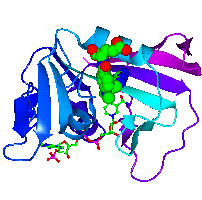Contents
IntroductionSelection language
 |
CCP4 Molecular Graphics Tutorials | |
| Selection Language |
| Documentation Contents | On-line Documentation | Tutorials | CCP4mg Home |
This documentation page has not been updated for CCP4mg 2.0. The page will be updated soon and will be available as part of the programs automatic update. If you have any queries meantime please contact ccp4mg@ccp4.ac.uk
This tutorial follows on from the Ligand binding site selection tutorial which describes using menu-based selection options and the simple interactive selection option. You will need to have loaded the model dUTPase.pdb.
CCP4mg has an internal selection language; when you choose a selection from the menu it is converted into selection rules such as
The following examples shows how to create more complex selections than are available on the menu.
Select the glutamic acid residues in an alpha helix. The menu has options to select particular secondary structure types or residue types but no obvious way to merge the two selections. To do this pick Interactive selection.. and Advanced from the atom selection menu. A new window appears but also all of the atoms in the model are displayed with thin bonds and the interactive selection tools on the right mouse popup menu are available as described above. In the new window the main text entry field contains the current selection command and you can edit the command manually but it is usually easier to enter commands using the interface above the entry field. To select GLU residues in helix try the following:
The text in the main window will be
/*/*/(GLU)/*
and amino_acid and SEC == H
Now to change the selection to all valine residues in helix you could just repeat the process above or, probably quicker, you could edit the selection command to replace the GLU with VAL and hit the Apply button.
It is not usually necessary to edit the selection command except to make minor corrections or to insert selection operators ('and','or','not') or curly brace which are used to denote the priority of selections. For example to change the selection above to find all the valine residues in helices or strands - you need to add the option of stands to the selection:
Finding all the histidine residues close to the side chain carboxy oxygens in glutamic acid residues.